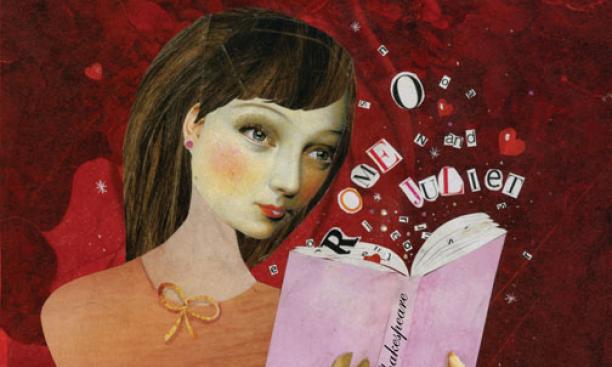

I fell in love with Romeo and Juliet when I was 8 years old. My parents had taken me to see a production of the play with Shakespeare & Company while we were on vacation in Massachusetts. At the outdoor theater, watching the actors dart out from behind trees in the moonlight, I was transfixed. “Night’s candles are burnt out, and jocund day / Stands tiptoe on the misty mountaintops,” Romeo said. The image sparkled in my mind. “My bounty is as boundless as the sea, / My love as deep; the more I give to thee, / The more I have, for both are infinite,” Juliet said, and I began learning about love long before I ever discovered it myself.
In middle school I began learning lines from the play, reciting them before I fell asleep, like incantations. As I’ve grown older, I have added to my reverence for the language a more intellectual exploration. Each time I see or read the play, I encounter something new. And my own intense experience of reading the play made me curious about all the readers who came before me.
During high school, I started my own tradition: Each time I go to a secondhand bookstore, I make a beeline for the Shakespeare section and look for Romeo and Juliet. The books I find on those dusty shelves usually are not valuable in the monetary sense; I’ve bought several copies for a dollar or so, many falling apart. But as relics created by readers of one of the greatest meditations on love ever written, each one is priceless, a clue to the staying power of this classic that is still one of Shakespeare’s most-performed plays and arguably the best-known love story in the English language.
As a former English major, I believe that textual analysis is an essential tool in understanding the resonance of a work of literature. As a lover of books, I also believe that we can achieve a fuller understanding by examining all aspects of a literary work aside from the words. Just as the format of a piece of correspondence — whether written in block or cursive letters, by hand or by typewriter or by e-mail — reveals something about the age in which it was composed, so too the marginalia and forewords and other information that document centuries of individuals’ experiences of Romeo and Juliet help us understand why this play has mattered to countless readers and audience members.
Take the oldest volume in my collection, for instance: a black, clothbound book, about 4 inches by 6. Published in London in 1833 by A.J. Valpy, it’s an ocean and nearly two centuries closer to Shakespeare than I am. But one thing is familiar: The spine is damaged so that the play falls open at the Queen Mab speech, suggesting that someone had read it many times before my then-boyfriend gave it to me.
A 1911 edition I picked up for 50 cents in a used bookstore in Vermont, on a road trip with a friend, is far from unique in certain ways. It’s a paperback, with a line on the front that reads, “Price, paper, 15 cents; linen, 25 cents” and the inscription “Number 212,” indicating that scores of identical books were printed. But the book is special to me because the preface, introduction, and notes were written by William Strunk Jr., one of the authors of the famous style guide that E.B. White embellished into the classic “Little Book.” “Unless love meets with obstacles,” Strunk writes, “it is not as a rule interesting to other people.” This is a play that inspires even this strict grammarian to question the nature of love. How many hands have leafed through the verses of this play? How many voices have read them aloud? No wonder Shakespeare said in the sonnets that poetry is a road to immortality.
In my 1960 copy, edited by Alfred Harbage and published in Baltimore by Penguin Books, two different handwritings dribble over the pages. One reader was a zealous underliner, running a blue pen down whole pages at a time. Where Juliet tries to keep Romeo at bay, saying, “It is too rash, too unadvised, too sudden; / Too like the lightning, which doth cease to be / Ere one can say it lightens,” this person has observed in all caps, with study-guide brevity, “POINT OF PLAY.” The other handwriting in the margins is sparser, more rounded, and less rushed-looking. When it appears, the writer gives stage blocking: In the final scene, he or she plans to have Friar Lawrence deliver his lines “going up stairs.” The rest of the pencil notes mostly cross out bits of scenes, leading me to believe that, far from the flat-footed commentator in blue pen, this reader was a director preparing for a performance. How different must their two reading experiences have been, and yet one must have read the other’s notes. The book shows directly the kind of community created by sharing a text.
In a 1990 Signet Classic version that I snapped off the secondhand shelves of Micawber Books on Nassau Street just weeks before the shop closed its doors, the notes suggest another hurried undergraduate. Most of the phrases underlined are the famous ones, the kind you find on coffee mugs and T-shirts and online quotation libraries (“What’s in a name?”). The notes are few and far between; the most legible, written next to Romeo’s speech immediately before he kills himself, reads, “die — sexual connotation, ‘orgasm.’” Never mind that the pun is far more relevant elsewhere; this was a reader who knew what he or she was looking for.
The other versions of Romeo and Juliet in my library are more modern copies that I’ve acquired new. But I still wonder how a future historian might perceive them. One is a Shakespeare Storybook, by Mary Macleod and published by Robert Frederick, Ltd. in Bath in 1994, a gift from my parents after that first time we saw the play together. With its glossy cover, pen-and-ink illustrations, and translations of Shakespeare’s verses into phrases with a syntax more easily parsed, it captured my imagination; at 8 years old I would shimmy under my covers and snuggle up to pore over it.
Another volume is a 2004 version I bought for an acting class my sophomore year at Princeton. My professor, Tim Vasen, gave us free rein to choose a Shakespearean monologue, and there was no question in my mind about which play to select. I performed Juliet’s Act 3, Scene 2 monologue, which begins, “Gallop apace, you fiery-footed steeds,” as she waits in her room for Romeo. Nearly every word in the 31 lines that follow is annotated in my copy now. There are stage directions, too: I delivered the first few lines looking out of the small window in our classroom at 185 Nassau Street; a few lines later I instructed myself to drape myself over the couch, then noted when I should sit up, when I should hug a pillow, how I could convey through my body all the passion in the play. I really got into it and noticed one boy blush.
And then there is my volume of the Complete Works, published by Houghton Mifflin Company; it’s a 3-inch-thick hardcover that I received as a present from my parents for my 16th birthday. This one is too precious to annotate; the only marking is a pinkish-brown stain where a rose I was pressing, also a birthday gift, bled through the pages.
I wonder what someone in the future might make of these volumes, whether they ever will be regarded as treasures by a reader like me, who uncovers them on the shelves of a secondhand bookstore. I hope so. I plan to continue adding to my Romeo and Juliet collection because each book has given me the chance to meet other readers, some from centuries ago, who, like me, have been touched by this play. “Love goes toward love as schoolboys from their books,” Romeo observes as he tears himself away from Juliet’s balcony after their first meeting. But for me, my books are a key to understanding the passion that keeps readers coming back for more.

